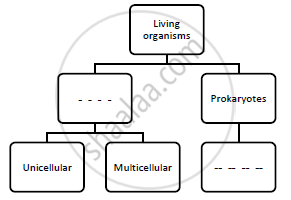Advertisements
Advertisements
प्रश्न
Answer in detail.
Explain the Kreb's cycle with reaction.
उत्तर

APPEARS IN
संबंधित प्रश्न
Name the life process of an organism that helps in the growth of its population.
What are outside raw materials used for by an organism?
What processes would you consider essential for maintaining life?
Which is the basic requirement of living organisms for obtaining energy?
Which of the following type of energy is used by living organisms to perform vital life processes? Kinetic energy, Chemical energy, Potential energy, Nuclear energy
Match the organisms given in column I with the processes given in column II:
| Column I | Column II | ||
| (i) | Leech | (a) | Holozoic nutrition |
| (ii) | Amoeba | (b) | Autotrophic nutrition |
| (iii) | Mushroom | (c) | Parasitic nutrition |
| (iv) | Green plant | (d) | Saprophytic nutrition |
Match the terms in column I with those in column II :
| Column I | Column II | ||
| (i) | Trypsin | (a) | Liver |
| (ii) | Amylase | (b) | Gastric glands |
| (iii) | Bile | (c) | Pancreas |
| (iv) | Pepsin | (d) | Saliva |
Skin : Keratin : : Blood : ____________
Rewrite the food-chain given below with correct sequence.
Grasshopper– Snake– Paddyfield– Eagle– Frog
Complete the following flowchart.
Fill in the blank and explain the statement.
Our muscle cells perform ______ type of respiration during exercise.
Write definition
Nutrients
Write definition.
Glycolysis
Distinguish between Glycolysis and TCA cycle.
Give scientific reason.
Kreb's cycle is also known as citric acid cycle.
Answer in detail.
How all the life processes contribute to the growth and development of the body?
Complete the following chart and state which process of energy production it represents:

Explain the ‘inhalation’.
Soil fertility is determined by its ability to :
Explain the Steps of Glycolysis.
How do the guard cells regulate opening and closing of stomatal pores?
Why do fishes die when taken out of water?
Match the words of Column (A) with that of Column (B)
| Column A | Column B |
| Phloem | (i) Excretion |
| Nephron | (ii) Translocation of food |
| Veins | (iii) Clotting of blood |
| Platelets | (iv) Deoxygenated blood |
In each of the following situations what happens to the rate of photosynthesis?
- Cloudy days
- No rainfall in the area
- Good manuring in the area
- Stomata get blocked due to dust
Match the terms in Column (A) with those in Column (B)
| Column (A) | Group (B) |
| (a) Trypsin | (i) Pancreas |
| (b) Amylase | (ii) Liver |
| (c) Bile | (iii) Gastric glands |
| (d) Pepsin | (iv) Saliva |
Explain the following concept in short:
Balanced Diet
Explain the following concept in short:
Role of circulatory system in energy production
Give one example of each of the classifications of vitamins.
